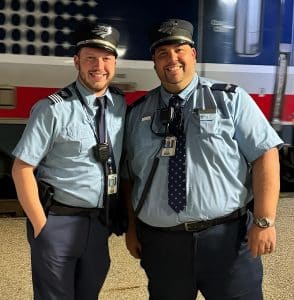Conductor Nathan Hatton arrived at work on August 9th ready for an ordinary shift. The twice-daily Amtrak run between Pontiac and Battle Creek, Michigan, is usually busy, but calm. Hatton and Dallas Jeffs, his assistant conductor, greeted passengers as they boarded.
One passenger, ticketed for the three-hour trip to Battle Creek, caught Hatton’s attention.
“This passenger was traveling a long distance, and yet he only had one small suitcase. When I greeted him, he was nonresponsive and avoided eye contact.” Hatton explained. The passenger was also wearing camouflage and knee pads.
LESSON 1: KNOW THE PATTERN AND WATCH FOR ANOMALIES

As the local chairperson for LCA-769A, Hatton attended SMART-TD’s 2024 National Training Seminar in July. His training included a session on de-escalation techniques for transit workers. Such training is part of the union’s ongoing effort to confront the rising epidemic of violent assaults involving bus and passenger rail workers across the United States.
“In the training we were taught to watch for things that stuck out to us as not normal. He was checking a lot of the boxes on the list. Things our instructor, John Bostain, told us to be aware of and not to blow off,” Hatton said.
Bostain, an instructor for Command Presence Training, modeled his course on techniques used by the U.S. Marine Corps to anticipate and, if possible, defuse tragic events.
“When anomalies start to pile up, it’s an indication something is potentially wrong,” Bostain taught. “That’s when the transit worker must decide what to do to protect the safety of themselves and their passengers.”
Hatton quietly shared his observations with Jeffs, and they agreed to keep an eye on their unusual passenger.
LESSON 2: WATCH FOR SIGNS OF A PERSON IS IN CRISIS
Early in the journey, the passenger stood from his seat near the front of the car, removed his case, and moved it to an easily accessible luggage rack behind all the other passengers. He returned to his seat for a time, then moved to the cafe car. Hatton observed as the man ordered three shots of gin.
“The single most important technique for dealing with people in crisis is not escalating,” Bostain wrote. It is easy to accidentally make a situation more intense through confrontation, when a tense situation calls for a delicate touch.
While the passenger was occupied in the bar, the conductors decided it was time to see what was in that case. Hatton kept watch while Jeffs opened the case and discovered multiple loaded firearms. Amtrak police were contacted and discreetly boarded the train in Jackson, an hour out from Battle Creek. Jeffs moved the case to a vestibule, out of sight of other passengers, where the officer could discreetly inspect it.
LESSON 3: STAY CALM, CREATE SPACE AND GET BACKUP
With 15 minutes left in the journey, the Amtrak police proceeded cautiously. By this time the passenger seemed intoxicated, and he may have been armed. While they kept watch, Hatton also contacted the Battle Creek Police Department. The man was detained as he stepped off the train.
REMEMBER YOUR TRAINING
While there is no way for Hatton and Jeffs to know the plan or intentions of the man, his behavior was erratic and, improperly handled, had the potential of being catastrophic.
By staying calm and working strategically, brothers Jeffs and Hatton may have saved their own lives, as well as several others.
For information on upcoming SMART-TD training opportunities, please visit our website and watch for announcements in our daily SMART-TD NewsWire emails.
